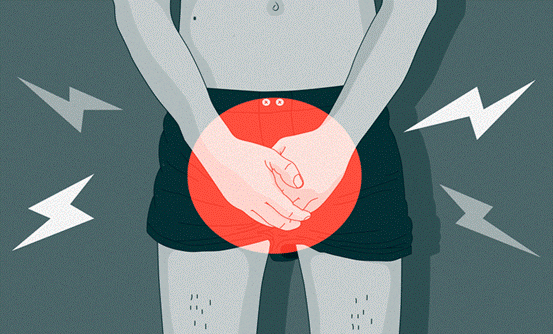The Ultimate Guide For Foreskin Problems
Foreskin is the retractable roll of skin that covers the end of the penis. When someone with a penis is born, the foreskin is also there but that’s not the case every time. Not everyone with a penis has one. This rare congenital condition is called Aposthia, also known as natural circumcision which refers to being born without a prepuce. Many people choose to or not choose to get circumcised on several grounds such as cultural, religious, medical and aesthetic/cosmetic reasons.
Foreskin requires extra care and it’s absolutely crucial because of the build up of smegma which we are going to talk about later on in the blog. The most important step towards foreskin care as well as awareness would be to get familiar with your own foreskin. Since this is delicate, both the foreskin and the stigma that surrounds it, it is very easy to ignore whatever problem you might be having because of that but that ends up doing more harm when it could be something that is easily treatable.
Gently washing the inside and the outside of your foreskin with mild, preferably unperfumed soap and warm water daily does wonders. This activity also helps in understanding and paying attention to any changes to your foreskin. If it is difficult to pull back the foreskin or if it is red, swollen and inflamed or has developed lumps, it is advised to go see a doctor to avoid any long-term damage to the foreskin or the penis.

What is Smegma?
Smegma is the dead skin cells, oil and other fluids that build up on the tip of the penis. Body cleans itself which involves unusual substances and smells. Smegma doesn’t mean that you have a STI or any type of infection. The amount of smegma depends on your personal hygiene. It is naturally released to keep the genitalia lubricated and not let it become dry and itchy. Smegma is more common in uncircumcised people because it can trap bacteria and fluids. Smegma can look like thick, cheese-like consistency, unpleasant smell and white or similar to skin colour buildup.
Smegma is not dangerous and definitely not a big issue to worry about unless you are not washing your genitalia well enough which can cause the fluids to accumulate and harden over time. If it is not taken care of on time, it can lead to painful side effects and become symptoms of some issues that we are going to talk about after this. In some causes, changes in the secretion and scent could indicate something more serious which can start with unusual smegma. And no, smegma isn’t a symptom and certainly can’t cause penile cancer alone, according to this source.

Foreskin Problems
We are now going to talk about common and not-so-common issues that affect the foreskin to help you understand your symptoms (if you have any) and help you put a name to your problem. The foreskin issues are as follows –
Yeast Infection (Thrush)
Thrush is a condition that causes dryness around and under your foreskin, tight foreskin, red and white bumps, cottage cheese-like discharge and irritation and inflammation. It is the result of overgrowth of a fungus known as Candida Albicans. You can get it from just having poor hygiene but also by having unprotected sex with someone who already has it or has poor hygiene. Treatment for Thrush includes antifungal creams, lotions, and ointments like Clotrimazole (Canesten) and Miconazole (Desenex) which are also available in the form of oral medication and meant to be taken only after you have been prescribed by a doctor.
Inflammation (Balanitis, Posthitis and Balanoposthitis)
Balanitis is a common infection that occurs at the head of the penis. This infection can affect people with penises of any age and is a symptom of other infections and diseases. The symptoms of Balanitis are itchiness or rash, pain and tenderness while urinating, chunky and foul smelling discharge, thickened skin, fluid filled blisters and foreskin being stuck.
Balanitis can happen when the inside of foreskin hasn’t been cleaned for a while. It can also happen if foreskin isn’t pulled back while washing or it can in the first place. Uncleaned thrush can lead to Balanitis because it’s common for inflammation to be caused by bacteria or fungus. Injury and irritation from certain chemicals such as perfumed soap, clothing, washing powder and latex in condoms can also cause balanitis. This could also result from allergies that can cause contact dermatitis. In adults, Balanitis can be a sign of diabetes since that increases the levels of sugar in the urine and the combination of sugar and humidity leads to bacterial and fungal growth if urine gets trapped under the foreskin, similar to yeast infection.
Posthitis refers to the condition where only the foreskin is inflamed and Balanoposthitis means when both the foreskin and the head of the penis is inflamed. These infections are symptoms of some STIs like gonorrhoea, herpes, syphilis, HPV, chlamydia, chancroid, trichomoniasis, etc. Other than maintaining good personal hygiene to prevent getting this, antibiotics and antifungals can be taken after advising a doctor if it is caused by infection.

Balanitis Xerotica Obliterans (BXO)
It is also known as Lichen Sclerosis. Despite having the same first name, this condition is not the same as Balanitis. BXO refers to a condition where scar tissues form at the tip of the foreskin which results in tightening the foreskin and making it difficult to pull back. This condition gets worse with time the more you wait to seek treatment. Both balanitis and BXO increase the chances of developing penis cancer as mentioned in this source, though it still remains very uncommon out of all cancers.
Phimosis
Phimosis is the condition where foreskin is too tight or the tip of the foreskin has narrowed so much that it can’t be pulled back to expose the glans penis and even if you can move it slightly, it is hard to do so without sensation of pressure or pain. Phimosis is often found in children or young adults, usually before puberty. Unretractable foreskin is common in young, uncircumcised people. Foreskin starts retracting after 3 years old and is fully retractable by the age of 17. It is not a matter of worry if it always doesn’t retract, the pain is the main concern.
Symptoms of phimosis include urinary tract infections (UTIs), urinary retention, skin infection on the penis, extreme pain when urinating, getting an erection and during sexual intercourse which can cause injury to the foreskin leading to minor bleeding, infection and scar tissues. In that situation, doctors might need to consider circumcision or partial circumcision.
Phimosis can happen for various reasons like after an infection or as a result of balanitis caused by poor hygiene or irritation from certain things. It can also happen after trauma or injury to the foreskin that causes foreskin to tear which is called secondary or acquired phimosis. When those tears heal, scar tissues can make retracting the foreskin way more difficult. Scarring from BXO and from pulling the foreskin before it’s ready age-wise can also cause phimosis.
Tightness of the foreskin can also be due to genetics. In that case, steroid creams are prescribed by the doctor for a couple of weeks to help with gentle, daily retraction of the foreskin to help loosen the tissue. If steroid creams don’t work or the phimosis is just too severe, circumcision is the best option.

Paraphimosis
Paraphimosis is the condition when foreskin is pulled behind the head of the penis and can’t go back to its original position. If the foreskin stays in that position, it can cause swelling and pain which can stop blood flow to the penis. Symptoms of paraphimosis range from swelling and tightness, pain followed by loss of sensation and change in the colour of the penis. Medical intervention is needed to avoid long-term damage to the penis since it can result in tissue death and in rare cases, it would be necessary to remove some or all parts of the penis.
It can be a result of an injury or trauma to the glans penis. This can happen at any age, including infants. If the individual pulls back the foreskin forcefully or leaves it retracted for too long, it could result in paraphimosis. Treatment-wise, the first thing to do is apply cold compresses to the area to help reduce the swelling and with the help of lubrication, try to pull the foreskin forward to its usual position. Doctors can also numb the area to try to move it back manually before injecting medication to reduce swelling. If that attempt is also unsuccessful, a surgeon would have to make an incision on the foreskin to release it or perform an urgent circumcision if it was needed.

What is Circumcision?
Since we talked about circumcision as the treatment for some of the foreskin related issues, it is good to know what it actually is. Circumcision is surgical removal of the foreskin that covers the glans penis. If you are already circumcised, your foreskin has been removed from its base which is near the middle of the penis shaft. It is usually done at birth and most parents choose to circumcise their children for religious, familial and cultural traditions. According to this source, 13.5% of the Indian population is circumcised. Older people also get circumcised to treat medical conditions or for purely personal/cosmetic reasons.
It is a more complicated surgery when it is done on older people since there’s at least 10 times higher risk of complications than that of infants. Serious complications are still rare. The worst complication you can get is inflammation, bleeding, and infection, which is easily treatable.
Circumcision has its advantages as well, it can lower the risk of getting UTIs, infections under the foreskin or tearing which may develop scar tissues and STIs like HPV, genital herpes, etc. There’s also a lower risk for penile cancer according to this research but that doesn’t mean that uncircumcised people are at more risk. There’s no need to worry if proper care is being taken everyday. You can still run into these issues even if you don’t have a foreskin. The only difference is that there’s a lower risk and possibility of having problems.

Conclusion
Even if you don’t have any of the symptoms from problems that were mentioned before but you feel like something isn’t right or just want to get information, it is always good to see a doctor before it gets worse if it is something to worry about. To avoid having issues this serious in the first place, basic hygiene tactics for the foreskin and the penis are in dire need. Thankfully, we have a blog on penile hygiene which you can give a read.
We are going to conclude this blog by mentioning a few basic foreskin care tips to add to your daily routine and maintain the foreskin and the penis health for the better. As we have mentioned before, washing the inside of the foreskin and the outside with just warm water and gentle, unscented soap can help keep the penis free of excessive smegma buildup. Chemicals and dyes in soap, detergents and in clothes can irritate the gentle skin as well. Things that are devoid of harsh chemicals, perfumes or dye can be a good first step to avoid irritation. Avoiding anything that could irritate the foreskin is also the way to go. For inflammation, a cold compress for not more than 20 mins is recommended. Putting on clean cotton or loose underwear every day is a must to avoid infection from trapped bacteria and moisture. Always urinating after sex and using protection also helps in protecting from penile and foreskin problems.
Cover Illustration: Narratively
Author

